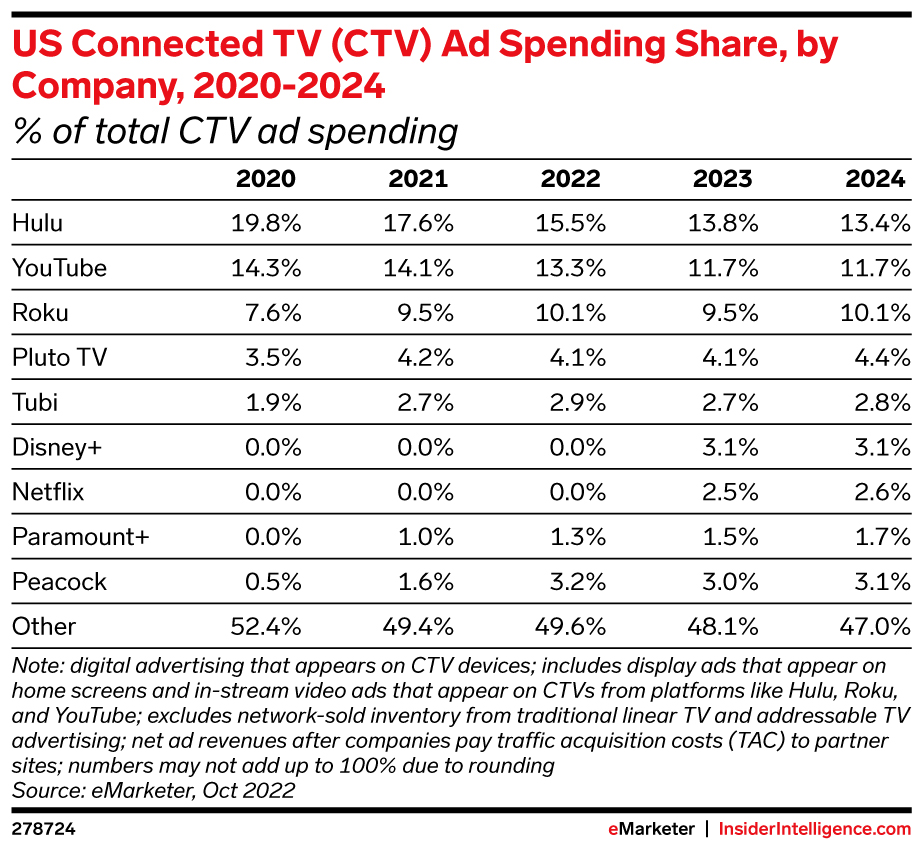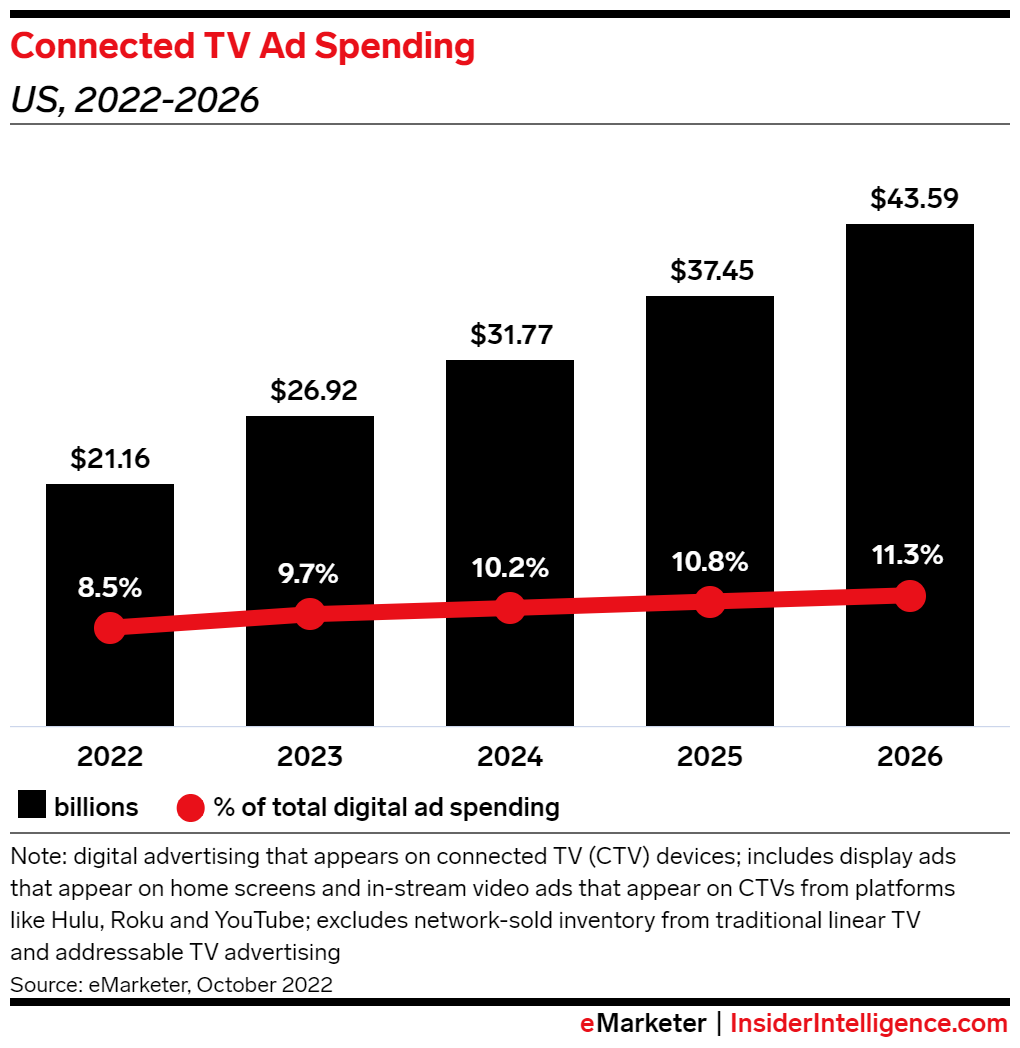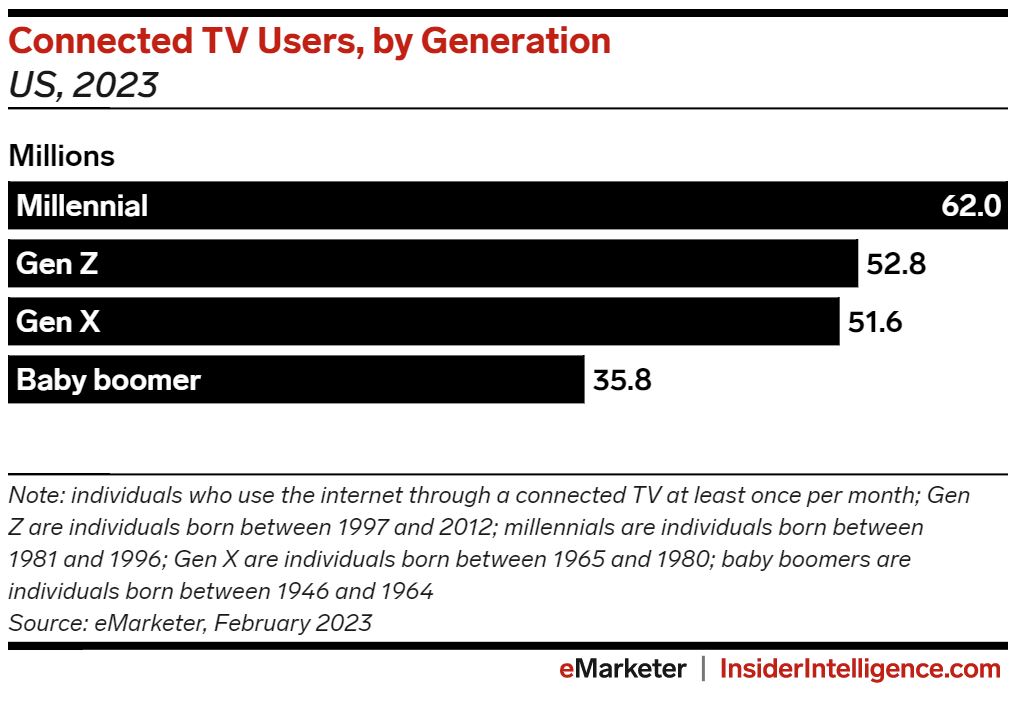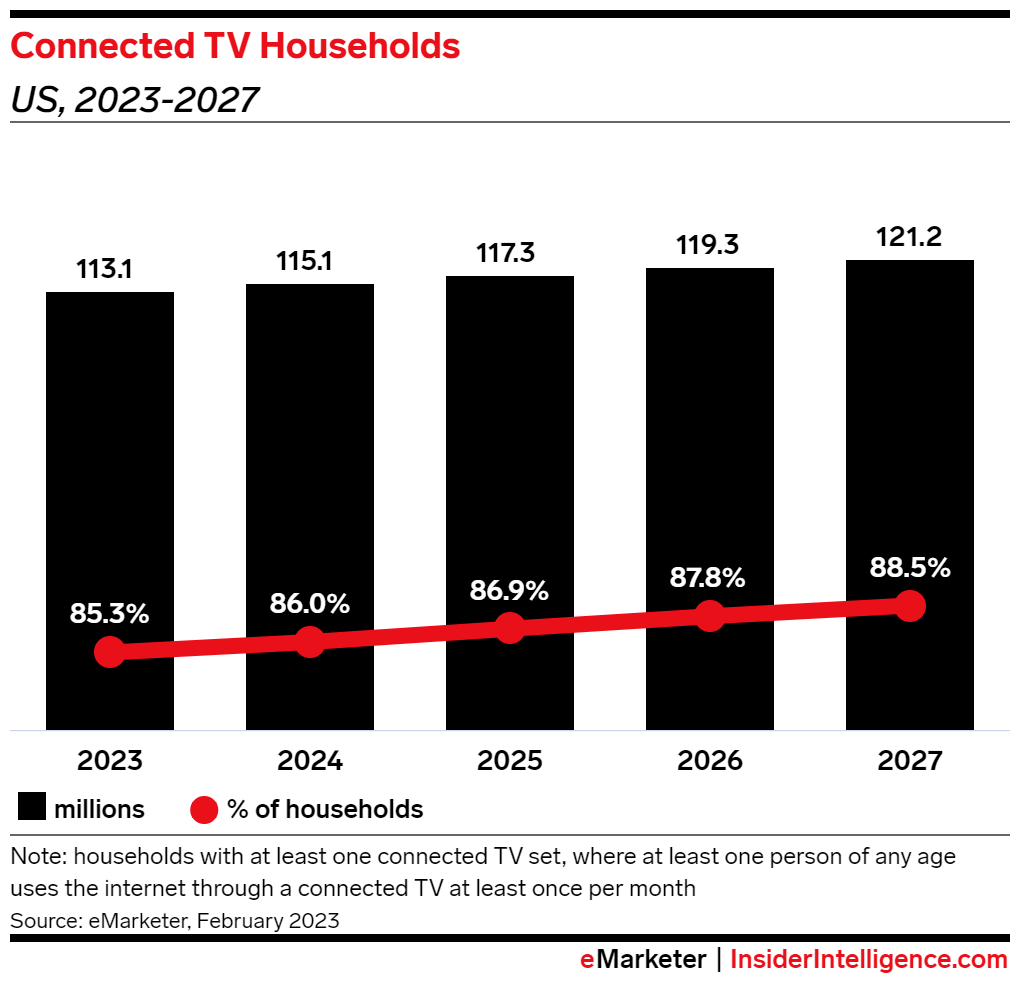What’s CTV? Advertising Tips for Connected TV Strategies

For evidence of the rise in streaming TV usage in recent years, most of us have to look no further than our own television sets. Streaming has taken the world by storm, and advertisers have certainly taken notice. In fact, 78% of all U.S. households subscribe to at least one or more streaming services and annual CTV ad spend in the US is expected to reach $43B in 2026.
“This market has grown by double digits each year since we began tracking it in 2017, and it will continue to do so through the end of our forecast period in 2026.” — eMarketer

But this new territory comes with its own set of major players, definitions, methods and manners of streaming content, and ad inventory and buying options. For those new to the streaming advertising landscape, it can seem like an entirely new path for which they have no directions.
In this post, we’ll work to take some of the confusion out of streaming ads by breaking down one of the most popular marketing avenues—Connected TV advertising.
A connected TV (CTV) refers to a TV that is equipped with internet connectivity and the ability to access and stream digital content. Unlike traditional TVs, connected TVs allow users to connect to online platforms, streaming services, and other internet-based applications directly through the television interface. This integration enables users to enjoy a wide range of multimedia content, such as streaming movies, TV shows, audio, and interactive applications, providing a more versatile and interactive viewing experience. Marketers have taken notice of CTV’s popularity and more and more advertisers are utilizing this platform to reach consumers while they watch.
Connected TV advertising includes digital ads shown to viewers who are watching streaming video content on an internet-connected television, including Smart TVs. Ads are displayed before, during/alongside, or after the television shows, movies, or livestreams being watched. Popular CTV ad types include display banners, traditional commercial-style placements, pop-up ads, and interactive ads that allow viewers to take direct action, often by using their phone camera or remote control.
Recent connected TV statistics highlight the incredible growth and opportunity already underway for CTV advertising, which is expected to continually climb for many years to come, include…
“In the US, CTV is the fastest-growing ad format we track, with a projected growth of 27.2% in 2023, for a total of $26.92 billion. By contrast, we project US retail media ad spend to increase by 20.5% and US social network ad spend to grow by 8.8% in the next year.” — eMarketer

‘Connected TV advertising’ and ‘OTT advertising’ are often used interchangeably, but there are practical differences between the two that relate most directly to the device on which the content is being consumed.
As their name implies, Connected TVs are able to deliver streaming content thanks to their “connection” to the internet. This connection is often built-in to the television, as is the case with Smart TVs, but a connection can also be facilitated through the use of after-market internet-capable devices, including the Amazon Fire TV Stick, Roku devices, gaming consoles, and Apple TVs.
While not all streaming content is viewed or listened to through a Connected TV, all CTVs deliver streaming video content. Looking at advertising specifically, CTV advertising would be viewed by prospective customers through apps they were accessing via their television screen. For example, while watching YouTube or streaming Twitch content on a Connected TV, viewers may be shown display banner advertising. That type of advertising is considered Connected TV advertising, but it is not OTT. OTT typically implies content streamed by a “network” like Hulu, NBC, or Pluto.
OTT is an acronym for “over-the-top,” and refers to streaming content that is “delivered over” (not through) a cable box. Unlike CTV advertising, which is exclusively shown on televisions, OTT advertising can be delivered on TVs, personal computers, tablets, mobile phones and more.
Addressable TV provides advertisers with 1:1 targeting in a traditional TV environment, enabling them to segment and deliver ads to selected, internet-connected linear TV and OTT/CTV audiences (households), thereby ‘addressing’ the audiences they want to reach through their ads. This level of targeting is accomplished by matching an advertiser’s first or third-party dataset to a cable TV provider’s dataset in a privacy-safe way.
The audience segments you’re able to target through Addressable TV advertising can be built on a number of factors, including specific demographics a viewer falls within, and their geographic location. Have you noticed you get different ads than your friends when you’re watching the same program? Addressable TV advertising is likely at play, serving up better-targeted-to-you-specifically ads, rather than traditional TV ads, where all viewers of the same program (and in the same region) are shown the same commercials.
Linear TV is what most of us think of as traditional TV, with cable or satellite programming and adjacent advertisements running on a largely predetermined schedule.
While linear TV watching is on the decline, there are still a very high number of subscribers. Advertising on linear can be incredibly impactful when leveraged in complement with CTV advertising. Targeting is available in the linear space, though it is often less granular than in streaming. Linear TV can be bought on a guaranteed demographic basis—i.e. a network can guarantee your ad will run to a certain audience (gender, HHI, etc)—with Addressable TV being a version of this.
Linear TV advertising can be beneficial for brands with an older customer base and very wide appeal, who want to reach the most varied group of potential consumers as possible—and it might be more affordable than you’d expect.
Key benefits of CTV advertising include enhanced targeting, real time measurement, and so much more. Let’s dive deeper into each of the benefits of CTV advertising.
CTV ad options are continuing to expand—particularly programmatic inventory—with audience targeting capabilities that rival what social media networks and Paid Search provide. Common targeting options include: age, location, gender, known interests, education or income level, and purchase history.
CTV has revolutionized advertising strategies by offering precise audience-based targeting, a departure from the traditional linear approach that primarily relied on broad demographic categories tied to broadcast schedules. With CTV, marketers can leverage first-party data to refine their targeting, ensuring ads reach the right audience. The platform provides a diverse set of targeting options, including retargeting, lookalike audiences, contextual targeting, geolocation, and time-of-day targeting. The ability to target down to the local level and even the IP level enables hyperlocalization.
For instance, marketers could promote ice cream in a walkable and hot neighborhood while adjusting ad spend in a rainy area. This not only allows advertisers to tailor their message to specific audiences but also reduces ad waste by reaching viewers at times when they are most receptive, enhancing the overall efficiency of advertising efforts.
CTV advertising provides advanced measurement and attribution capabilities that offer advertisers valuable insights into campaign performance. Through various tracking mechanisms, advertisers can gauge the impact of CTV ad exposure on both online and in-store consumer behavior. Utilizing advanced measurement tools, advertisers can access metrics such as ad impressions, engagement rates, and conversions.
CTV also allows advertisers to correlate ad views with physical visits to brick-and-mortar locations. For instance, a retail brand running a CTV campaign may observe an increase in foot traffic to their stores following exposure to a specific ad. This granular level of measurement provides actionable data, allowing advertisers to refine their strategies and allocate resources effectively. CTV’s advanced measurement and attribution capabilities make it a powerful tool for advertisers looking to understand and optimize the impact of their campaigns on consumer behavior both online and in-store.
CTV ads achieve higher completion rates for a wide variety of reasons. CTV ads can be precisely targeted, ensuring relevance to the viewer’s interests and demographics. It’s also good to keep in mind that viewers engaging with CTV content are often in a relaxed atmosphere, sitting on the couch rather than actively in front of a computer or phone where ad skipping ads is more common. This type of audience is more likely to watch the entire ad, which leads to improved completion rates.
Certain CTV ads are designed as unskippable, a feature not easily found across all advertising mediums. This unskippable nature enhances ad exposure, contributing to higher completion rates, making CTV a great platform for advertisers aiming to capture and retain viewer attention.
The great news with CTV advertising is that results are often deterministic and available in real-time, meaning you don’t have to wait weeks or months to adjust based on performance. This is a significant departure from the more rigid timelines of traditional linear TV. Unlike linear TV, where ad slots are typically purchased well in advance, CTV ads can be dynamically sold through real-time bidding. This flexibility gives advertisers the opportunity to make on-the-fly adjustments to campaign spend, content, and placements based on real-time performance data.
Metrics like revenue, website visits, and store visits can be tracked in real time, providing immediate insights into campaign effectiveness. This real-time information empowers advertisers to optimize their strategies on the go, making CTV one of the most powerful and responsive performance marketing channels available today. For example, imagine a retail client running a CTV campaign promoting a flash sale. By monitoring real-time data, the advertiser can quickly identify which creative elements are driving the most website visits and revenue, allowing them to adjust the campaign in real time to maximize impact and ROI.
Not only are there 113 million CTV households in the US, but those households include a large number of people from all current adult-inclusive generations. Whether you want to reach Gen Z, Gen X, Millennials or Baby Boomers, you’ll reach them all by the tens of millions with CTV ads (Source).

The use of programmatic advertising is on the rise for CTV media buys, though it isn’t the only way to purchase ad space. Because most CTV ad inventory is “delivered against premium video content from broadcast TV, cable, and streaming studios,” there is often a heightened degree of brand safety. (Source)
CTV advertising also offers the advantage of automated optimization and media buying strategies, providing marketers with the flexibility to choose between partial or full automation. Even fully automated campaigns benefit from some oversight, ensuring decisions align with broader business goals. Leveraging a powerful analytics solution is key to making informed decisions in real-time, utilizing available data to maximize campaign efficiency.
When working in the CTV ad space, marketers should collaborate with experienced streaming agencies or media buyers to strike the right balance between the efficiency gained through automation and the nuanced value of human decision-making. This collaboration ensures that campaigns not only capitalize on the speed and precision of automated processes but also align with the strategic insights and creativity that human expertise brings to the table.
CTV advertising operates by showcasing video ads on internet-connected television screens through various streaming services and apps. These ads can be displayed on popular platforms such as Hulu, Roku, Amazon Fire TV, and others, reaching a huge audience of over 113 million streaming viewers. The targeting capabilities of CTV advertising are vast, allowing advertisers to tailor their messages based on demographics, interests, and viewing behaviors. Devices supporting CTV ads include smart TVs, streaming devices, and gaming consoles.
The data collected from CTV campaigns can be repurposed across other channels for a holistic marketing approach. For instance, insights gained from CTV campaigns can inform strategies on social media or traditional TV advertising. Additionally, data from other channels can be integrated to enhance the precision of CTV campaigns. This interconnected approach ensures a comprehensive and effective advertising strategy.
Navigating Connected TV advertising requires a strategic approach that starts with understanding the intricacies of purchasing CTV ads. Let’s explore the step-by-step process of buying these ads, from setting goals to choosing platforms, ensuring marketers have the insights needed to harness the power of CTV in reaching their target audiences effectively.
When starting a CTV advertising campaign you need to lay out clear, well-defined goals right off the bat. Utilizing the SMART goals (Specific, Measurable, Achievable, Relevant, Time-bound) can be a great place to start. Before diving into the complexities of CTV ad buying, marketers should ask themselves key questions such as who their target audience is, what specific metrics define success, and what realistic milestones can be achieved within a designated time frame.
Establishing SMART goals not only provides a roadmap for the campaign but also helps in aligning objectives with broader business strategies. Clearly defined goals offer a benchmark for measuring success, enable a more efficient allocation of resources, and facilitate a focused, results-driven approach. By starting with well-crafted goals, marketers can ensure that their CTV advertising efforts are not only impactful but also seamlessly integrated into the overall marketing strategy.
The advanced targeting options CTV advertising offers are what draws many advertisers to this avenue, with the measurable results keeping them coming back.
Consider the audiences you want to reach, and the actions you want them to take, in deciding who you’ll target with which creative and placements. Consider the audiences available within the platforms themselves, audiences you might want to reach based on your own first-party data, which KPIs you are interested in measuring, and whether measuring incrementality is important.
If you’re lacking first-party data, it’s important to consider incorporating third-party data into your strategy. Third-party data enriches your understanding of audience segments, allowing for more precise targeting based on demographics, interests, and behaviors.
When selecting a CTV platform, it’s crucial to consider the various buying options available. CTV ad space can be secured through direct sales, private marketplaces (PMPs), or programmatic buying. Direct sales involve direct negotiations with the platform for ad space, offering a more hands-on and personalized approach.
PMPs provide a curated marketplace with selected publishers, offering a balance between control and scale. Programmatic buying, on the other hand, utilizes automated technology for real-time ad placements across a multitude of inventory. To choose the right platform, assess your campaign goals, target audience, and budget constraints. Consider the platform’s reach, targeting capabilities, and available analytics. Whether you opt for direct sales, PMPs, or programmatic, understanding the nuances of each method is key to optimizing your CTV ad strategy. Whatever strategy you choose, we do recommended tapping in an experienced advertising agency to help with overall negotiations, perfecting ad placement, maximizing your budget, and so much more.
Let’s break down the common CTV devices and platforms…
CTV Devices are the physical products that facilitate watching streaming content. In the Connected TV space, that includes Smart TVs (internet-capable by design), and regular TVs that have been “made smart” through the use of an after-market, internet-capable device (Roku devices, gaming consoles, Apple TVs, Amazon Fire TV Sticks, and more.)
CTV Platforms are the apps and services that viewers will be watching when they see your CTV ads. Some popular, ad-supported platforms include:
Whether you want to start small with one CTV platform, or design a fuller campaign that targets viewers across a variety of popular apps, there are an abundance of options to suit your goals and needs.
Once you’ve selected a platform or platforms, explore all the available ad types offered by that provider. There are an expanding number of platforms to choose from, with some popular options including YouTube and Hulu. Once you understand the foundational capabilities of each, you can better design a campaign that leverages a mix of ad options and/or audiences.

When selecting your preferred CTV ad type, it’s essential to be mindful of the diverse placement options offered by different platforms. Consider when and where your ad will appear to tailor your messaging effectively.
For instance, if your ad is set to display during a viewer’s program pause, design it to be eye-catching, ensuring that the message is absorbed in that brief moment. Interactive elements, like incorporating a QR code for viewers to take immediate action, can enhance engagement. Whether it’s pre-roll, mid-roll, or pause-screen ads, understanding the nuances of each placement ensures your message aligns seamlessly with the viewer experience, maximizing the impact of your CTV advertising campaign.
Measuring and optimizing your CTV advertising campaign is integral to ensuring its success, and the beauty of Connected TV lies in its high measurability. CTV provides comprehensive insights into your entire marketing funnel, allowing you to gauge the impact of your ads at every stage. Metrics such as viewability, completion rates, and click-through rates offer a nuanced understanding of audience engagement.
The advantage of near-real-time data availability allows for quick course correction, ensuring your campaign stays on track. Like all digital advertising campaigns, there is no set-it-and-forget-it approach. Once you’ve given your ads enough time to reach statistically significant results, carefully review what’s working best, and where there might be room for improvement. Consider the full scope of what can be influencing these results, including targeting and the creative itself.
Adopt a dynamic approach by consistently reviewing and optimizing based on what works best, considering factors like targeting effectiveness and the creative elements. In the realm of CTV, continuous refinement is the key to unlocking optimal results for your advertising efforts.
While the available ad units can vary from platform to platform, there are certain ad types that are most common. Below, we dive into four popular and widely-offered CTV ad types…
Display ads on CTV function similarly to the display ads we see elsewhere, including on our favorite websites and blogs. These ads appear above, below or alongside the content being viewed, helping increase and improve brand awareness.
eMarketer estimates that “CTV will account for 16.5% of all US display ad spend” in 2023.
In-stream video ads are served to customers once they’ve begun a streaming session. These ads can be shown before, during, or after they’ve viewed their selected content. In-stream video ads are most similar to what most of us consider traditional television commercials.
Instream ads are the most common ad type shown “on platforms like YouTube,” and are also commonly referred to as pre-roll, mid-roll, and post-roll video advertisements.
Interactive ads are a newer ad type that viewers can interact with in some way when they are displayed, with a few different interactive options. These might include scanning a QR code shown on the screen to be taken to a website, or sent more information via email. Some interactive ads even enable viewers to make a purchase, or add an advertised item to their cart, directly from the ad.
CTV pop-up ads include those that display beneath the content being viewed, or when a streaming viewer has paused their programming. These ad types don’t require that users interact with them in any way, helping boost brand awareness without interrupting their streaming session.
Different platforms offer a variety of audience targeting options, including the ability to target based on your own data. Below, we explore some of the most common and popular targeting options.
In real estate and advertising, location matters! Even if brands plan to advertise heavily across the US and beyond, targeting their ads by location can help improve relevance and expand their messaging options.
For example, you might not want to waste money letting viewers in California know that your warmest winter coats are on sale. Or, perhaps your product names or available options vary by location? In these instances, you can enlist different ads for each location to eliminate any confusion, or cause upset when customers can’t find an advertised item near them.
For many products and services, to make the most of your advertising dollars, selecting specific demographics to target can help reduce costs without sacrificing hitting your desired audiences. Different household demographics advertisers might want to target include: people of certain ages, income levels, or education levels; homeowners / renters; and parents of young children.
Targeting by platform enables advertisers to reach only viewers using specific devices. This is typically done if you want to reach viewers that you know will be more interested in your product or service because they’re using a complementary product, or to reach viewers using a competing/different product that you hope to convert.
Contextual targeting aims to serve ads that ‘make sense’ in context with the content that is being viewed.
For example, if a viewer is watching a program about running, ads for athletic wear and sneakers would make good contextual sense. You can assume with relative certainty that most viewers watching a television program or movie about running might have interest in those items.
Channel targeting allows advertisers to reach viewers on a specific network. This can be especially beneficial if your product aligns with an overall theme of a given network.
For example, a company that sells bathroom lighting fixtures might want to target all viewers watching HGTV as many of that network’s shows are focused on home renovation projects. This would give reasonable certainty that a sizable number of viewers may be interested in making their own renovations, or that they’ll remember your brand in the future when they are. It also means your advertising will almost always work in harmony with the content a viewer is watching.
Because CTV advertising is typically part of a larger digital marketing plan, it can be beneficial to leverage first- and third-party data in your audience targeting. This can include your first-party analytics and CRM data, and third-party audiences offered by CTV platforms.
Frequency caps are limits on the number of times a given viewer will be shown your CTV ad. Due to CTV having a fragmented landscape across many networks, services, and platforms, without frequency caps in place, the same viewer may receive your ad numerous times in a short period of time—sometimes even repeatedly during the same ad break. To avoid annoying viewers with repetitive ads, caps can help you preserve your ad effectiveness and brand safety.
The measurability of streaming advertising on the whole makes it an attractive channel for advertisers of all niches and budgets. Some of the key metrics and measurements to help you track your CTV advertising performance include:
With customers rapidly shifting from cable and satellite television to streaming TV, advertising options like CTV ads make an increasingly sound investment for advertisers trying to reach any audience.
It’s also important to note that many viewers, particularly those who have grown up watching streaming television, understand that ads are part of the equation. They are open to ad-supported video content when the tradeoff is a lower (or free) subscription that grants them access to quality content.
Want to learn more about CTV and other forms of video and streaming advertising? Visit our Performance Streaming services page, download our Ultimate Guide to Performance Streaming, or reach out today to chat with an expert.
Editor’s Note: This post was originally published by Shannon Mullery in March 2023 and has been updated for freshness, accuracy, and comprehensiveness.
